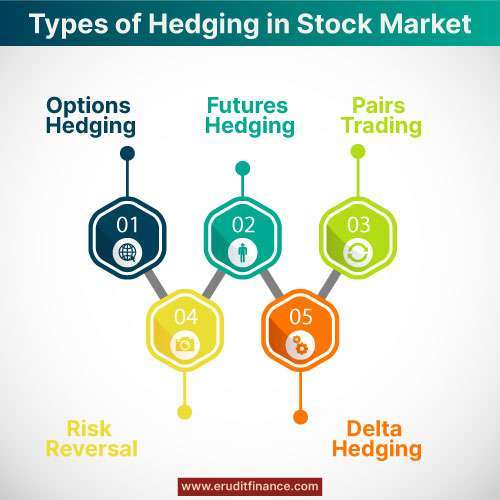Hedging in the stock market is a risk management strategy where investors use various financial instruments to offset potential losses from adverse price movements. By employing derivatives such as options, futures, or other hedging tools, investors aim to protect their portfolios against market volatility. Hedging allows for a more balanced approach to investing, minimizing downside risks while still participating in potential upside movements. This strategic use of financial instruments helps investors navigate uncertainties and safeguards their positions, offering a level of stability in the ever-changing landscape of the stock market.
Hedging in Stock Market
Hedging in the stock market is a strategic risk management technique utilized by investors to minimize potential losses arising from unfavorable price movements. This approach involves the use of various financial instruments, particularly derivatives, to create a balanced and protected investment portfolio. Here are key points to understand about hedging in the stock market.

Objective- The primary goal of hedging is to safeguard investments against market volatility and adverse price fluctuations.
Derivatives Usage- Investors commonly employ derivatives such as options and futures contracts for hedging purposes.
Options Contracts- Investors can buy put options, granting them the right to sell an underlying asset at a predetermined price within a specified timeframe. Put options act as insurance, providing a hedge against potential declines in asset values.
Futures Contracts- Investors use futures contracts to agree to buy or sell an asset at a predetermined future date and price, mitigating potential losses.
Risk Reduction- Hedging helps in reducing the overall risk exposure of an investment portfolio, especially during uncertain market conditions.
Institutional Importance- Institutional investors and corporations with significant market exposure often employ hedging strategies to protect their financial positions.
Currency Hedging- Multinational companies may use financial derivatives to hedge against currency risk, minimizing losses due to exchange rate fluctuations.
Trade-Off- While hedging provides protection, there are associated costs, and it doesn’t eliminate all risks. Investors must weigh the costs against the potential benefits of risk reduction.
Effectiveness- The effectiveness of hedging strategies relies on accurate predictions of market movements and the chosen financial instruments.
Continuous Monitoring- Successful hedging requires ongoing monitoring and adjustment of positions to align with changing market conditions.
Types of Hedging in Stock Market
Hedging in the stock market involves employing various strategies and financial instruments to mitigate the impact of adverse price movements on an investment portfolio. Here are common types of hedging techniques used in the stock market.
| Options Hedging | Pairs Trading | Diversification | Delta Hedging | Cross Hedge |
| Futures Hedging | Risk Reversal | Straddle & Strangle | Dynamic Hedging | Tail Risk Hedging |

1). Options Hedging-
a). Protective Puts- Investors buy put options to limit potential losses on existing holdings. If the market moves unfavorably, gains on the put options can offset losses on the underlying assets.
b). Covered Calls- Investors hold a long position in an asset and sell call options to generate income. This strategy can help offset potential losses if the asset’s price declines.
2). Futures Hedging- Investors use futures contracts to hedge against potential price fluctuations in the underlying asset. By taking an opposing position in the futures market, they can protect against losses.
3). Pairs Trading- Involves taking simultaneous long and short positions in two correlated assets. The objective is to profit from the relative performance of the two assets while minimizing market exposure.
4). Risk Reversal- Combines options trading to create a synthetic long or short position. It involves buying a call option and selling a put option or vice versa to hedge against potential market movements.
5). Diversification- Investing in a diverse range of assets with low correlation can act as a natural hedge. This approach helps spread risk across different instruments and industries.
6). Straddle and Strangle- Involves buying both call and put options with the same expiration date and strike price (straddle) or different strike prices (strangle). Traders use this strategy when expecting significant price volatility.
7). Delta Hedging- Adjusting the position in options or futures to neutralize the overall market risk. Traders monitor the delta, representing the sensitivity of the option’s price to changes in the underlying asset’s price, and make corresponding adjustments.
8). Dynamic Hedging- Involves continuously adjusting the hedge based on changing market conditions. This approach requires active monitoring and real-time adjustments to maintain an effective hedge.
9). Cross Hedge- Hedging an asset using a derivative that is not directly related to the asset. For example, using commodity futures to hedge currency risk.
10). Tail Risk Hedging- Protecting against extreme market events or “tail risks” by using options or other strategies designed to provide insurance against significant downturns.
Each type of hedging strategy has its advantages and disadvantages, and the choice depends on the investor’s risk tolerance, market outlook, and the specific characteristics of the investment portfolio.
What Is an Example of Hedging?
An example of hedging involves an investor holding a substantial portfolio of technology stocks and being concerned about potential market volatility. To mitigate the risk of a market downturn, the investor decides to employ a protective put option strategy. In this scenario-

Current Portfolio- The investor currently holds a significant amount of technology stocks, which could be susceptible to price fluctuations.
Protective Put Option- The investor purchases put options on the technology stocks within their portfolio. These put options grant the right, but not the obligation, to sell the stocks at a predetermined price (strike price) within a specified timeframe.
Risk Mitigation- If the market experiences a decline, the value of the technology stocks may decrease. However, the protective put options act as a form of insurance. If the stock prices fall below the strike price, the investor can exercise the put options, selling the stocks at the higher predetermined price, thus limiting their losses.
Cost of Hedging- The investor acknowledges that purchasing the put options involves a cost, which is essentially the premium paid for acquiring the insurance against potential losses. This cost is the trade-off for reducing the downside risk.
Upside Potential- While the protective put strategy limits potential losses, it also allows the investor to continue participating in any potential upside movements in the stock market.
This example illustrates how an investor can use hedging strategies, such as protective puts, to manage risk and protect their portfolio against adverse market conditions. While hedging involves costs and trade-offs, it provides a level of security and peace of mind for investors concerned about the impact of market volatility on their investments.
Is Hedging a Good Strategy?
Hedging can be a good strategy for managing risk in certain situations, but its effectiveness depends on various factors and the specific goals of the investor. Here are key considerations.
| Pros | Cons | |
| Risk Management | Hedging is an effective tool for mitigating potential losses in the event of adverse market movements. It provides a level of protection against uncertainties and volatility. | There are costs associated with hedging, such as the premiums paid for options or the potential drag on returns from maintaining hedging positions. |
| Market Conditions | In highly volatile or uncertain markets, hedging can be a prudent strategy to safeguard investments. | In stable markets, the cost of hedging may outweigh the potential benefits, and investors may miss out on potential gains. |
| Investor Objectives | For risk-averse investors or those with specific liabilities, hedging can align with their goals of preserving capital and maintaining a more stable portfolio. | Investors with a higher risk tolerance may find hedging to be restrictive and prefer to take on more market exposure. |
| Complexity & Costs | Hedging allows for customization and flexibility in managing risks associated with specific assets or market conditions. | Implementing hedging strategies can be complex, and the associated costs (such as transaction fees and premium payments) should be carefully considered. |
| Active Management | Hedging requires active monitoring and adjustments, allowing investors to adapt to changing market conditions. | Investors who prefer a more passive or buy-and-hold approach may find the ongoing management of hedging positions to be demanding. |
| Trade-Offs | Hedging provides a trade-off between potential costs and the benefits of risk reduction, allowing investors to strike a balance based on their risk tolerance and market outlook. | Over-hedging or misjudging market movements can lead to missed opportunities and additional costs. |
Is Hedging Legal in Trading?
Yes, hedging is legal in trading, and it is a common and widely accepted practice in financial markets. Hedging involves using various financial instruments, such as options, futures, or other derivatives, to offset or mitigate the risks associated with price fluctuations in assets.
Key points regarding the legality of hedging in trading include-
a). Regulatory Oversight- Hedging activities are subject to regulatory oversight, and financial markets have established rules and regulations to ensure fair practices, transparency, and investor protection.
b). Risk Management- Hedging is primarily used as a risk management strategy. Investors and institutions engage in hedging to protect their portfolios against adverse market movements and to manage exposure to different types of risks, such as currency risk, interest rate risk, or commodity price risk.
c). Derivatives Trading- Many hedging strategies involve the use of derivatives, such as options and futures contracts. Derivatives markets are regulated, and participants are required to adhere to established rules and standards.
d). Financial Institutions- Banks, hedge funds, and other financial institutions commonly engage in hedging activities as part of their risk management practices. These institutions operate within the framework of financial regulations and compliance requirements.
e). Investor Freedom- Individual investors also have the freedom to use hedging strategies to protect their investments. Online trading platforms and brokerages often provide tools and instruments that allow retail investors to hedge against market risks.
f). Transparency and Disclosure- While hedging is legal, financial institutions and corporations are often required to disclose their hedging activities in their financial statements. This enhances transparency and helps stakeholders understand the risk management practices in place.
What Are the Disadvantages of Hedging?
While hedging is a valuable risk management strategy, it has its disadvantages and challenges. Here are some of the drawbacks associated with hedging.

| Costs | Transaction Costs– Executing hedging strategies involves transaction costs, including fees and commissions, which can erode potential gains.
Premium Payments– Purchasing options or other derivatives for hedging purposes involves paying premiums, reducing overall returns. |
| Complexity | Hedging strategies can be complex, requiring a thorough understanding of financial instruments and market dynamics. Novice investors may find it challenging to implement and manage effective hedging strategies. |
| Over-Hedging | Misjudging market movements or overestimating risks can lead to over-hedging, where the costs of the hedge exceed the potential losses. This can result in missed opportunities for gains. |
| Reduced Profit Potential | Hedging limits the downside risk but also restricts the potential for profits. Investors may miss out on significant gains if the market moves favorably. |
| Market Timing | Successful hedging often relies on accurate market timing. Mistiming market movements can lead to ineffective hedges or missed opportunities. |
| Management Overhead | Implementing and managing hedging positions requires ongoing attention and analysis. Constant monitoring and adjustments can be time-consuming and may require a level of expertise. |
| False Sense of Security | Relying too heavily on hedging can create a false sense of security. Investors may become complacent, assuming that all risks are adequately mitigated, potentially overlooking other factors affecting their portfolio. |
| Basis Risk | Basis risk arises when the correlation between the hedging instrument and the underlying asset deviates from expectations. This can result in incomplete risk mitigation. |
| Counterparty Risk | Derivative contracts involve counterparties, and there is a risk that the counterparty may not fulfill its obligations. This is known as counterparty risk and can affect the effectiveness of the hedge. |
| Regulatory Changes | Changes in regulatory environments or accounting standards may impact the effectiveness or availability of certain hedging instruments. |
It’s essential for investors to carefully weigh the advantages and disadvantages of hedging and to tailor their approach based on their risk tolerance, investment goals, and market conditions. While hedging can provide valuable protection, it requires careful consideration and ongoing management to balance the trade-offs associated with risk reduction.
How Many Companies Use Hedging?
A significant number of companies, ranging from small businesses to large multinational corporations, use hedging strategies as part of their risk management practices. The prevalence of hedging varies across industries and depends on factors such as the nature of the business, exposure to different types of risks, and the company’s risk tolerance.
| Multinational Corporations | Financial Institutions | Real Estate Companies |
| Export-Import Businesses | Manufacturing & Supply Chain Companies | Technology Companies |
| Commodity-Dependent Industries | Airlines and Transportation Companies | Pharmaceutical and Healthcare Companies |
What Are the Key Hedging Techniques?
Hedging involves various techniques to manage and mitigate risks associated with price fluctuations in financial markets. Here are key hedging techniques commonly used by investors and businesses:
1). Options Hedging-
- Protective Puts: Investors purchase put options to hedge against potential declines in the value of their holdings.
- Covered Calls: Investors sell call options on existing holdings to generate income and partially offset potential losses.
2). Futures Hedging- Investors use futures contracts to lock in prices for future transactions, protecting against adverse price movements in the underlying asset.
3). Forwards Contracts- Similar to futures contracts, forwards allow participants to agree on a future transaction at a predetermined price, providing a hedge against price volatility.
4). Currency Hedging- Companies and investors use currency derivatives, such as forward contracts or currency options, to hedge against fluctuations in exchange rates.
5). Commodity Hedging- Businesses in commodity-dependent industries use futures or options contracts to hedge against price volatility in raw materials.
6). Interest Rate Swaps- Entities with variable-rate debt may use interest rate swaps to convert variable interest payments into fixed payments, protecting rising interest rates.
7). Cross Hedging- Hedging one asset with a derivative based on a related but different asset. For example, using commodity futures to hedge currency risk.
8). Natural Hedging- Companies naturally hedge by aligning their assets and liabilities in the same currency or by matching revenue and expense streams.
9). Delta Hedging- Adjusting the position in options or futures to neutralize the overall market risk, to maintain a delta-neutral portfolio.
10). Pairs Trading- Simultaneously taking long and short positions in two correlated assets to profit from the relative performance while minimizing market exposure.
11). Tail Risk Hedging- Employing options or other derivatives to protect against extreme or tail risk events in financial markets.
12). Portfolio Diversification- Spreading investments across diverse asset classes to reduce concentration risk and provide a natural hedge against specific market movements.
13). Dynamic Hedging- Continuously adjusting hedge positions based on changing market conditions to maintain effective risk mitigation.
14). Rollover Hedging- Rolling over or extending existing hedging positions to cover future periods, allowing for continuous risk management.
15). Risk Reversal- Combining options to create a synthetic long or short position, involves buying a call option and selling a put option, or vice versa.
Choosing the appropriate hedging technique depends on the type of risk being addressed, the characteristics of the underlying assets, and the investor’s or company’s specific risk tolerance and objectives. Successful hedging requires careful consideration, ongoing monitoring, and adjustments based on evolving market conditions.
Bottomline:-
Hedging in the stock market is a prudent risk management strategy where investors use various financial instruments to offset potential losses resulting from adverse price movements. Whether employing options, futures, or other derivatives, the primary goal is to safeguard investment portfolios in the face of market volatility. While hedging provides a protective shield, it comes with costs and complexities. Investors must carefully balance the trade-offs, considering transaction expenses, premium payments, and the potential limitation of profit potential. Effectiveness hinges on accurate market timing and continuous monitoring. Hedging allows investors to navigate uncertainties, offering a level of security in a dynamic stock market environment while acknowledging the need for strategic, well-informed decision-making.
Also Read:










